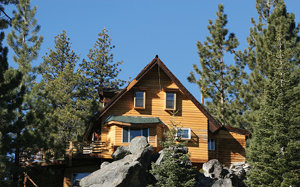Log Siding

Log siding is valued for its rustic appearance that recalls pioneer homes and cabins in the woods. Rather than using whole logs, log siding is made of cut trees shaped in quarter- or half-logs or is manufactured of composite wood and polystyrene. As a result, log siding provides the look of traditional log homes but uses less wood, is easier to install, and costs less.
How Log Siding is Produced
Log siding is made of milled wood, whereas traditional log homes are made of handcrafted logs that have been peeled of their bark but to which little other changes have been made. Siding is created using a manufacturing process that converts logs into timbers that are consistent in size and appearance. The wood is kiln dried to reduce moisture content and prevent too much shrinking once in place. Engineered log products combine waferboard, polystyrene, and wood which are pressed into log-shaped planks and a veneer is applied to give them the appearance of the natural product.
Types of Log Siding
The two most important types of log siding are natural logs and engineered logs. Beyond this fundamental difference, both products offer much of the same features including type of wood (pine or cedar), smoothed wood or hand-hewn appearance, quarter logs or half logs, and tongue and groove shaping for easy installation. Planks usually come in standard sizes: 2 x 6 or 8 inches, or 3 x 6, 8 or 10 inches. The log siding may be pre-stained or have a coating to protect the wood against the weather.
Warranties on Log Siding
Warranties vary by manufacturer and usually cover the following: that goods sold were of the grade represented, were kiln dried, and are free from defects in manufacturing or workmanship. Limited warranties cover the cost of replacement or repair of products that were installed and maintained according to manufacturers' instructions only. They do not cover damages to buildings on which the log siding was installed. Engineered wood logs are covered for 15 years against manufacturing defects.
Common Problems with Log Siding
Logs that are not properly dried in kilns can shrink, crack or warp. Some defects may not appear for several years after installation. All wood must be maintained regularly to protect it from damage from the sun, rain and snow. Some woods bleed pitch - the sticky substance also known as pine gum. Pitch can be removed once dried using a scraper or buffing brush or while still wet using denatured alcohol.
Environmental Impact of Log Siding
The production of all log siding requires the cutting down of trees - either live or dead. Pine and cedar are relatively fast-growing trees, so log siding uses a moderately renewable resource if trees are replanted. Natural log siding uses whole trees but with planks shaped in half or quarter logs; these require less wood than traditional whole log construction. Engineered wood log siding uses up to 75 percent fewer trees, so it's a preferable product in the view of environmentally friendly building advocates.
Popular Log Siding Brands
- Dura Log
- e-Log by Pine River
- Glu-Lam-Log, Inc.
- Logfinish
- Modulog
- Rustic Rails
- Sierra Log Siding
- Wood Workers Shoppe
